The Surface 3 Review
by Brett Howse on May 4, 2015 9:00 AM ESTBattery Life
When you consider something like a tablet, battery life is a crucial part of the complete package. Tablets are not meant to be plugged in for really any of their normal usage. In the case of the Surface 3, it has a 28 Wh battery onboard to power it when not plugged into the wall. That is a fair bit less than the 42 Wh battery that is crammed into the Surface Pro 3, but with a less powerful CPU, and a slightly smaller display, it may be able to compete.
To test battery life, we have several tests and for a device like the Surface 3 we will compare it to a couple of device types. First up, we will compare it against other tablets on our Wi-Fi test, which consists of basic web browsing. Next we can compare to notebook computers with our light test (again, web browsing) to get a feel for how it performs against those devices.
Surface 3 features Connected Standby support, but after a few hours of being asleep it will switch to hibernation. This is the same as the Surface Pro 3, and it helps tremendously with standby times. Although we do not have a test for this, in my time with the device I found that standby times were excellent, which makes sense since the device is actually turning off after a few hours. This does make for a bit longer wakeup the next time you need it, but it is a better result than the device being out of battery.
To enable a level playing field for all of the devices, we set the display brightness to 200 nits for all battery life tests, and disable any adaptive brightness.
Tablet Battery Life
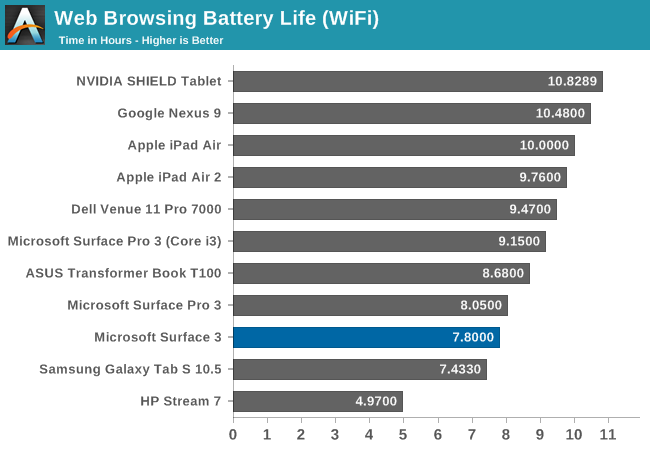
Compared to other tablets, the Surface 3 has pretty poor battery life. On our web browsing test, the Surface 3 came in at just under eight hours. The iPad Air 2 has a similar size battery, but manages almost two hours more battery life in this test. The CPU workload is fairly light in this test, but without a complete breakdown of all of the parts inside it would be difficult to pinpoint exactly what is the issue here.
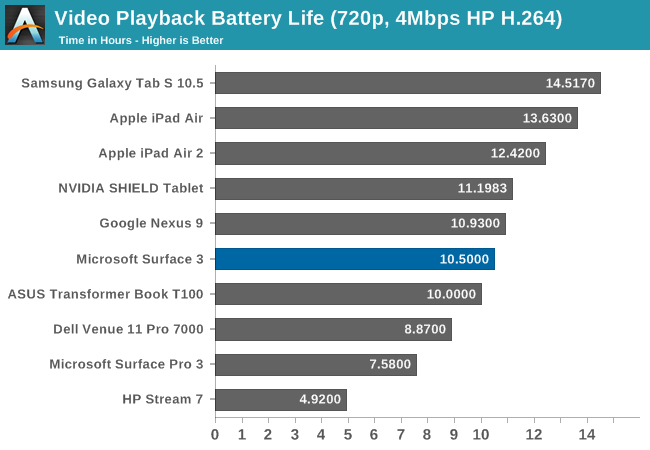
Update: May 18, 2015
After some discussions with Intel, I discovered that the battery life while playing back video was lower than it should be. Further digging into this issue found that the script being used to log the battery life time affected the tablet video playback test dramatically and resulted in much worse battery life result than was warranted. I have re-run this test several times with no script and was able to achieve 10.5 hours at 200 nits which is a much more respectable result. Further testing determined that this only affected the video playback times, and the other results were unchanged whether the script was running or not.
When this review was first published, we had tested the battery life at 7.72 hours of video playback. Upon subsequent research, it was determined that part of our logging in our battery life test caused an issue for unexpected CPU usage outside of the video decoder, and as a result, we are realigning the result to 10.5 hours. The issue in our test, based on retests of other devices, is currently only limited to the Surface 3 and specifically only to the video playback test.
On the video playback, the Surface 3 stumbles even farther, although the overall battery life is almost identical to the web browsing test. On the video playback many tablets are able to offload the work to hardware. Once again, without being able to check each part of the tablet individually it is not very easy to determine what is causing this weak battery life result.
So compared to tablets, the Surface 3 is about mid-pack in the video playback tests, and below average for web browsing. I hoped for a better result.
Laptop Battery Life
We have a different set of tests for notebook computers, so I also ran the Surface 3 through our light workload which is a different browser test.
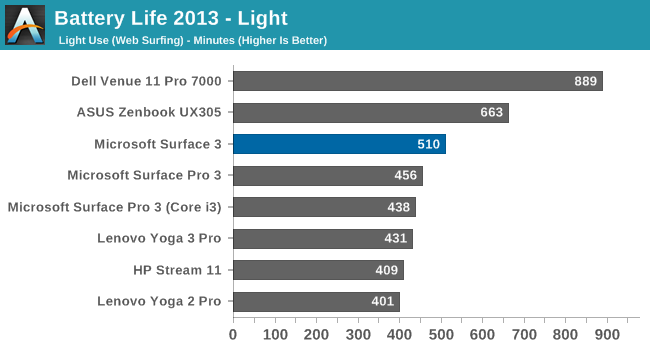

The Surface 3 manages to outperform the Surface Pro 3 here, and at 8.5 hours on our light test, it is a decent result.
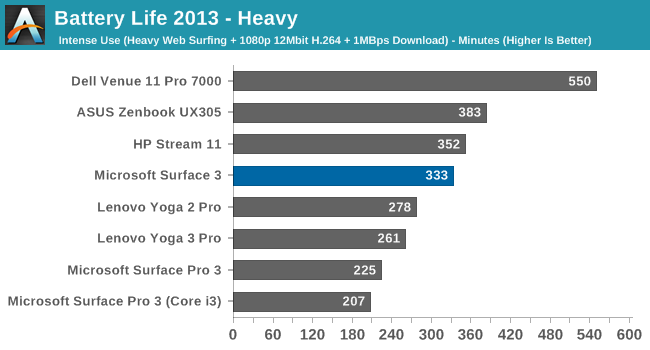
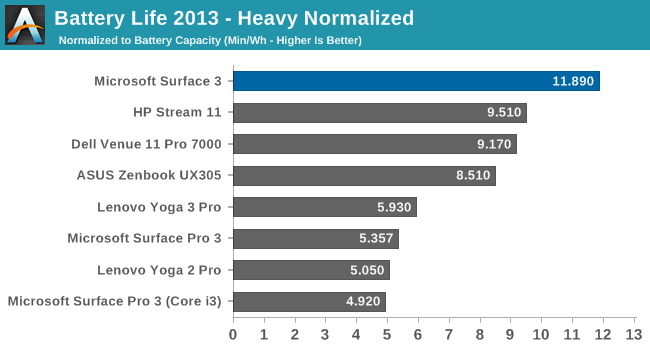
The situation is very similar under our heavy test. The Surface 3 once again outperforms the Surface Pro 3 here, however now it's by quite a bit more than it did under the Light test. Meanwhile compared to the Core M devices, only the Venue 11 remains well in the lead; the UX305's lead is down to 15%. Ultimately with a 2W SDP, the bulk of the Surface 3's power consumption is in the display, so ramping up for our heavy test does not have the same impact on overall power consumption as it does on devices with more powerful SoCs/CPUs. Meanwhile the situation also sees the Surface 3 do well on a normalized basis, well ahead of any other device with respect to the number of minutes of runtime per watt-hour of battery capacity.
Charge Time
The other aspect of mobility is charge time. Although longer battery life would always be a priority, the ability to quickly top up a device can make it a lot more useful in the real world where you are not always away from an outlet.
Charging time is always going to be a function of the battery size and the supplied charger’s ability to fill that battery. In the case of the Surface 3, Microsoft has shipped it with just a 13 watt charger, and when it is charging, only about half of that is available to the battery with the rest designated to power the system.
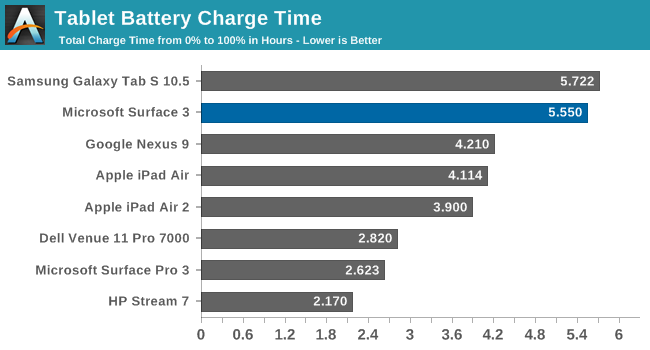
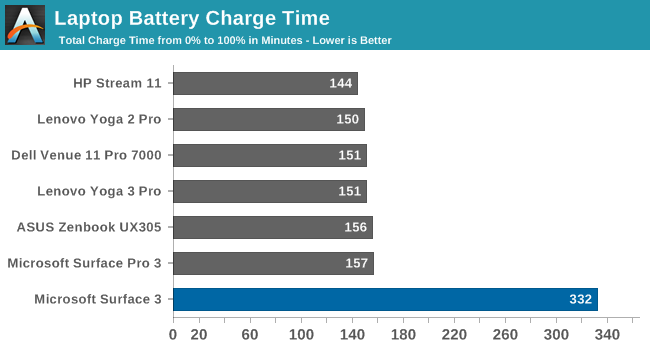
Compared to notebook computers, the charging time is quite a bit longer than we are used to seeing. The Surface Pro 3’s proprietary charging connector was able to charge quite quickly, but the Surface 3 is really quite slow. Part of this comes down to the micro USB connector which is now the charging connector.
This connector is just not built for the high amperage needed to quickly charge a device up. Although I am happy to see Microsoft ditch the previous charging connector, this is where a USB Type-C connector would be much better. It can handle a lot more power, and it would have allowed the Surface 3 to come with a much higher wattage adapter. It really feels a bit like putting one foot in the past with the micro USB port. The long charge times were quite an issue for me trying to review this device, since we run our battery life tests multiple times to ensure a reliable result, but there was a very long wait to get the device ready for another run.


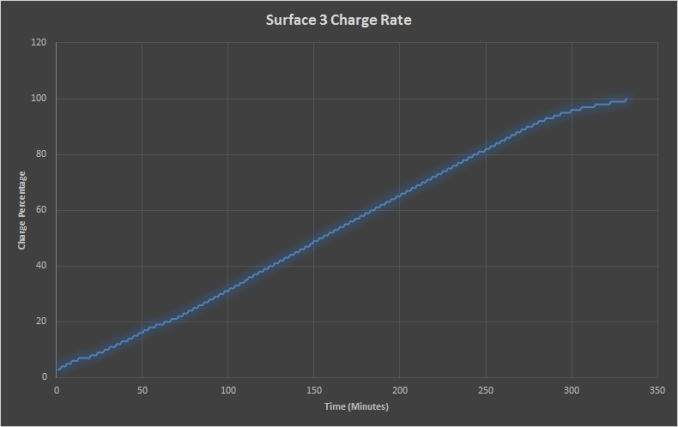








265 Comments
View All Comments
MrSpadge - Monday, May 4, 2015 - link
Using legacy apps (which are still called programs) should be fine with the pen. Except for the high DPI display - depending on how legacy the app exactly is.Alexvrb - Monday, May 4, 2015 - link
It runs touch-friendly modern apps (including Universal apps which will be getting a boost in the near future) as well as more traditional software. You can use just about any external accessory that you can with a regular PC. If you use the dock and a larger monitor this can even replace the desktop for many users. In many ways it is more versatile than the devices you mentioned.stephenbrooks - Saturday, May 9, 2015 - link
Actually a lot of programs designed for mouse input (click and drag) work pretty well on a touchscreen Windows machine. The main problem is the buttons tend to be too small for fingers.It would be great if Microsoft could have an option to magically enlarge GUI elements a bit when in touch mode.
jaydee - Monday, May 4, 2015 - link
When I say lack of apps, I mean as designed as portable tablet. That's what MS is touting, it's a tablet and laptop in one.Of course it has tons of apps as a Win8/10 device, but if that's all you're really after, why buy something that straddles the line between laptop and tablet? Why not an XPS 13 or Spectre x360? Proportionally few of those Windows apps tend to run real well on a 10" touch screen with a resolution of 1920x1280.
It just seems to be in an odd place. I'm not sure what it does really well, other than its display. CPU/RAM/SSD are all compromised as a laptop and it's too expensive for what it does as a tablet. It's not "bad" by any means, I really do *want* to like it, it just doesn't seem to do the laptop thing well enough, be a tablet at a low enough price point. And I'm someone who would like to replace my iPad Air with something convertible like this. But if I'm going to buy a laptop that can also be used as a tablet, it's either going to have to have higher performance, or be cheap enough to not feel bad replacing in a couple years, and I don't feel either with this (particularly with accessories). I'm much more apt to get the i5/8GB/256GB HP Spectre x360 @$1,000, while more expensive, I feel much better about thinking about using for the next 5 years, compared to the Surface $600 + type cover + dock @ $930 and still has a tablet mode. The Surface Pro 3 is nice, but I'm not sure what it offers over the Spectre x360, at a sales price of ~$1,130 (retail $1,300), not to mention being a gen behind with Haswell still. If history is any indication, I will like the SP4 as a product, but probably not at it's price point.
Impulses - Monday, May 4, 2015 - link
If the base model included 4GB and/or they at least threw in the pen for free with certain combos, it'd be more enticing. It's still an attractive package for people who just want a secondary system, but a lot of those are just gonna end up with cheaper tablets or more capable laptops.Even tho it's significantly cheaper than SP3, and it's exactly what a lot of people said the base Surface should've been all along, it still feels like less of a value proposition than SP3. Better storage and Type C might've made it more appealing...
As it is it feels too much like something they'll refine significantly for the next rev... Big EDU discounts could sway things tho. A simple $100 student discount would make it a $530-630 hybrid competing against $400-500 tablets and $750+ laptops, much better sweet spot.
simard57 - Thursday, May 7, 2015 - link
Costco has a bundle that includes keyboard and pen for $100 more over the 2GB and 4GB modelsillegaloperation - Monday, May 4, 2015 - link
How much is portability worth to you?The HP Spectre x360 weigh over twice that of the Surface 3.
Also, why is the Dock being factor into the price? The Dock is nice to have, but it's hardly essential.
The0ne - Monday, May 4, 2015 - link
Just curious, what apps are you missing one the Windows platform? For someone like me who would use this for work, I can't imagine an app that is not available that I would use. You mean it doesn't have the hundreds and thousands of useless apps that are in all markets? Always confused by this statement.jaydee - Tuesday, May 5, 2015 - link
In order for it to be considered a good "tablet", it has to do all those things that tablets are known for. Apple and Android have this tremendously large ecosystem that many people are vested in and there's a huge selection for. Obviously "entertainment" apps are going to be useless for people who use this for work. Just like the "productivity" apps aren't useful for those who use it for entertainment, etc. Certainly, the Windows tablet is a better match for a certain type of productivity user like yourself, then a gamer per se. What a tablet has come to be, for many people though is a ubiquitous device that transcends both genres and I don't see that in the Windows platform. Not to mention the fact that Apple/Android tablet users are going to have a hard time switching over if they've invested a decent amount of money into their Apple/Android apps.Like I said, I really want to like this device, but it just feels like too many compromises as a laptop and a mixed bag as a tablet. Does that mean that it's not a great device for some people? Absolutely not! I just don't see it doing one (laptop) or the other (tablet) well enough to break through mainstream and be a big seller at this price point. As other people have mentioned, if it were a lower price or included accessories or faster storage or Core-M instead of Atom were here, I would probably feel much different, but it's too many compromises as is.
Gigaplex - Monday, May 4, 2015 - link
With Windows 10, Microsoft is aiming to bridge the "App gap" by making porting of iOS and Android apps to Windows fairly trivial.